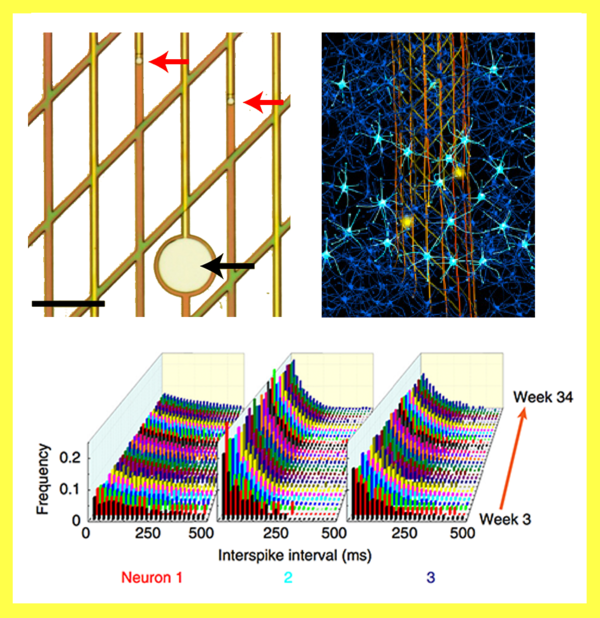the very real science behind Elon Musk's Neuralink investment
News Nugget
Why this Matters
How can we evolve with our technologies, and not fall behind? In the model where we separate our evolution from technology, we risk becoming so different from our child-technologies that there is no communication or collaboration between generations. We would erase ourselves from an ecosystem that we ourselves created.
It begs the question, who are we? I believe that our selves are a combination of the stories we tell ourselves (our software), the social ties that support us (our network), and the physical bodies that sustain us (our hardware).
Quick Takes
It’s all over the news. Elon Musk has done it again. From SpaceX to Tesla, and now Neuralink and Kernel. This man wants to merge computers with the brain, and he wants to do it in the next four to five years.
And no, he is not a believer in the coming age of robot domination or artificially intelligent overlords. He wants humans to evolve with artificial intelligence, not behind it. But, enough about Elon. Let’s get to the science.
- Part I: The Mind of Matter, Delving into Consciousness
- Part II: The Hardware of Us, A Forest of Neurons
- Part III: The Anatomy of Machines, the Chemistry of Transistors
- Part IV: Transistor, Meet Neuron
‘Borg Mice: Neural Lace in the Brain
Yes, you can inject flexible wires and transistors into the brain and measure the activity of individual neurons. Basic unit of computer, meet basic unit of brain. We just haven’t done it in humans yet.
Imagine a syringe with a mesh of 16 wires crumpled inside. At the end of each wire is a field-effect transistor, which can measure electrical outputs from individual neurons. The syringe narrows at the very tip to an 80µm needle, the width of a fine human hair. Each wire inside the needle is about 800nm thick, one hundred times thinner than your eyelash.
Over the last several years, a team led by Charles Lieber, the Mark Hyman Professor of Chemistry at Harvard University, used these needles to inject a breathable mesh of wires into the dense brain tissue of mice.
Why is the word ‘mesh’ so important? Imagine the way that grapes grow on a trellis, in the same way, neurons grow on the mesh. Because the mesh is a long, thin cylinder with very fine threads, it bends at about 0.1 nN m, the same way that brain tissue itself bends.

The material itself is also biocompatible, and generates no immune response, therefore neurons have no problem getting ‘up close and personal’ over a long period of time with the mesh itself.
The lace is so flexible that you could even put it in between the vertebrae of your spine, moving, running, and jumping with no interference.
In Your Heads Next Year (just kidding, like 5 years)
This science is a long way away from human use. If you take just one look at the exposed mice brains with wires hanging out, you’ll know why. If you’re not a surgeon or a butcher, it’ll turn your stomach.
There is also a long and expensive FDA approval process that sits in between today’s science and tomorrow’s application. The technology needs to go through a rigorous series of animal testing before it can even be tested on humans. For non-invasive therapies such as Alzheimer’s drugs, typical human trials can cost upwards of $100M. You can therefore imagine the testing cost for an invasive neural mesh. (hint: $$$$$$^$$)
At first and soon, it will be used for the desperate, the people who wouldn’t mind having their skulls cracked open, or like Neil Harbisson below, the world’s first cyborg artist born without the ability to see color.

One application is for Parkinson’s patients, who already benefit from deep brain stimulation, a much cruder form of electrodes implanted deep into the brain. However, the effects are known to wear off, potentially because the implant is not fully biocompatible, resulting in neurons moving away from the implant.
Given that a neural mesh is a large improvement over current FDA-approved deep brain stimulation techniques, it’s reasonable to assume that the technology will be in use within ten years.
Or as Elon Musk optimistically stated in Vanity Fair:
“For a meaningful partial-brain interface, I think we’re roughly four or five years away.” — Elon Musk
Technologies for Tomorrow: Think Your Way to Inbox Zero
Once engineers are able to reduce invasiveness, and designers are able to make the product look and feel palatable, the technology is a powerful brain computer interface.
Imagine that this technique is applied to your brain. A small hole no larger than the tip of a pencil is drilled through your skull, in a minimally invasive procedure at a clinic. A hair-thin needle then injects a mesh into a non-essential part of your brain, along with a small dose of neuronal growth factor to help your brain heal and grow around the mesh. The wires run under the skin of your scalp to a bud behind your ear. You leave with a bandaid.
After two weeks, you can now train yourself to use the mesh. Each wire connects to either a single neuron or neuronal cluster. Two-way feedback training, which you can do on your commute in your driverless vehicle, allows you to learn how to control which neuron-transistor pair you are activating. At this point, you are ready to call a driverless Uber using your mind.
While memory enhancement may be difficult with only 16 channels (wires) it is certainly within the realm of possibility to slightly increase the channel load and complete simple tasks such as navigate file systems (similar to the simplicity of the Terminal interface) or access your email using only your thoughts.
Just please, no push notifications.
Human :: Machine as Stories : Software, Social : Network, Bodies : Hardware
These aspects of ourselves exist in a delicate balance, one which we don’t yet fully understand. Mostly because it requires being able to logically process, analyze, and simultaneously experience a range of emotions; a much harder task than simply creating a deep learning algorithm in Python.
So the question is, what aspects of our humanity are we willing to risk when we change the balance of our selves by amplifying our own intelligence?
Useful Links
Musk launches company to pursue ‘neural lace’ brain-interface technology. Elon Musk has launched a California-based company called Neuralink Corp., The Wall Street Journal reported today (Monday, March 27, 2017), citing people familiar with the matter, to pursue “neural lace” brain-interface technology.
Will This “Neural Lace” Brain Implant Help Us Compete with AI? Solar-powered self-driving cars, reusable space ships, Hyperloop transportation, a mission to colonize Mars: Elon Musk is hell-bent on turning these once-far-fetched fantasies into reality. But none of these technologies has made him as leery as artificial intelligence.
Cyborg Tissue Monitors Cells. Researchers at Harvard University have constructed a material that merges nanoscale electronics with biological tissues — a literal mesh of transistors and cells.
Research Papers
Syringe-injectable electronics : Nature Nanotechnology : Nature Research. (Lieber, et al. 2015) Rolled-up ultraflexible mesh electronics can be injected through a syringe needle of diameter as small as 100 μm into man-made and biological cavities, gels and tissues, where they can unfold and perform sensing operations.
Stable long-term chronic brain mapping at the single-neuron level : Nature Methods : Nature Research. (Lieber, et al. 2016) Flexible mesh electronics facilitate stable long-term recordings of the same single neurons in mouse brains over months, enabling chronic recordings in behaving animals and longitudinal studies to resolve aging-dependent changes in neural activity.

News Nugget
Why this Matters
How can we evolve with our technologies, and not fall behind? In the model where we separate our evolution from technology, we risk becoming so different from our child-technologies that there is no communication or collaboration between generations. We would erase ourselves from an ecosystem that we ourselves created.
It begs the question, who are we? I believe that our selves are a combination of the stories we tell ourselves (our software), the social ties that support us (our network), and the physical bodies that sustain us (our hardware).
Quick Takes






